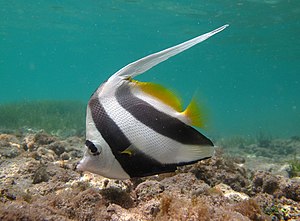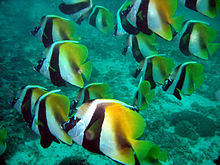Banner fish
| Banner fish | ||||||||||||
|---|---|---|---|---|---|---|---|---|---|---|---|---|

Common banner fish ( Heniochus acuminatus ) |
||||||||||||
| Systematics | ||||||||||||
|
||||||||||||
| Scientific name | ||||||||||||
| Heniochus | ||||||||||||
| Cuvier , 1816 |


The banner fish ( Heniochus ) are a genus of butterfly fish (Chaetodon) living in the Indo-Pacific and Red Sea .
features
Banner fish have a tall, laterally flattened body and reach a length of around 17 to 30 centimeters. Their small mouth is covered with many bristle-like teeth. The extended first fin rays of the dorsal fin give the genus its name (ἡνίοχος. Gr., "Chariot, rose driver", from ἡνία "reins": the pennant interpreted as a scourge).
Fin formula : Dorsal X – XIII / 21–27, Anale III / 17–19,
Often the soft rayed part of the dorsal and caudal fins of the fish are colored yellow.
By shape and Beflossung is Heniochus sp. not a good long-term swimmer. In the short term, however, the representatives of this genus can be relatively quick. In addition, they are very maneuverable, which benefits them in the coral reefs and serves to quickly disappear into the cracks and crevices of the reefs.
nutrition
Banner fish feed on bottom-dwelling small invertebrates or on zooplankton .
behavior
Competition
The pennant of these fish is erected when threatened. In the competition itself, two opposing opponents lower their heads and erect their "pennants". They face each other forehead to forehead during a fight and press their pennants together, which looks like two crossed blades. So they try to push each other away, with the upper part of the black bands fading. After the pushes, the "parallel gallop" takes place. The two opponents swim close to each other for a long distance and then start pushing their foreheads again. After the fight, the loser stands across in front of the opponent, lowers the pennant and turns his backside away from the winner.
Reproduction
Like most butterfly fish, banner fish enter into permanent marriage with their partners. Mating takes place in the late afternoon. The couples swim to the surface of the water to spawn, and there they release their gametes together.
The eggs are less than a millimeter in size and float on a tiny drop of oil for about 24 hours on the water. Then the transparent larvae hatch . After the larval stage, the young animals seek out shallow reefs, where they live in larger clusters and grow quickly, and take on the color and behavior of the adults. Sexual maturity occurs towards the end of the first year of life.
Systematics

Banner fish belong to the butterfly fish. Its sister genus is Johnrandallia , and Hemitaurichthys and the tweezer fish of the genus Forcipiger are also closely related . The taxon formed by these four genera is the sister group of Amphichaetodon , Coradion , Chelmon and Chelmonops , all eight pennant and pincer fish genera are in a sister group relationship to the actual butterfly fish ( Chaetodon (including Parachaetodon and Roa ) and Prognathodes ).
species

- Common banner fish ( Heniochus acuminatus ) (Linnaeus, 1758)
- Pacific bannerfish ( Heniochus chrysostomus ) Cuvier, 1831
- Swarm Bannerfish ( Heniochus diphreutes ) Jordan, 1903
- Red Sea Bannerfish ( Heniochus intermedius ) Steindachner, 1893
- Masked bannerfish ( Heniochus monoceros ) Cuvier, 1831
- Phantom bannerfish ( Heniochus pleurotaenia ) Ahl, 1923
- Malay bannerfish ( Heniochus singularius ) Smith & Radcliffe, 1911
- Black bannerfish ( Heniochus varius ) (Cuvier, 1829)
literature
- Brockmann, D. (2000): Fish and corals in the sea and in the aquarium . Birgit Schmettkamp Verlag
- Herald, ES (1961): Knaur's animal kingdom in colors, fish . Droemersche Publishing House
Individual evidence
- ↑ Fessler, JL & Westneat, MW (2007): Molecular phylogenetics of the butterflyfishes (Chaetodontidae): Taxonomy and biogeography of a global coral reef fish family . Mol. Phylogenet. Evol. 45 (1): 50-68. doi : 10.1016 / j.ympev.2007.05.018
Web links
- Bannerfish on Fishbase.org (English)
